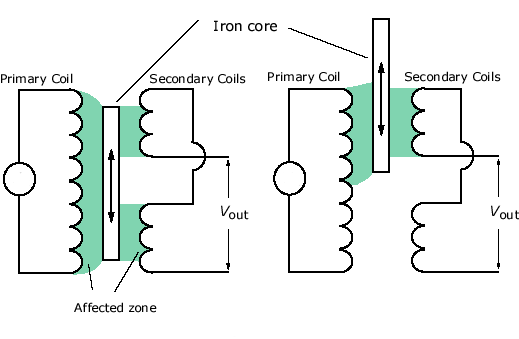Monitor - ISSN 1472-0221
The Newsletter for Data Acquisition and Control
Issue 267 February 2021
Hello and thank you for subscribing - our best wishes for the coming year.
You can download a pdf copy of this newsletter here.
Contents
* Measuring Small Changes in Position
* Your Data Acquisition Questions Answered
* Data Acquisition News Round-Up
Measuring Small Changes in Position
When monitoring small movements people often use a Linear Variable Differential Transformer (LVDT). You can use an LVDT, for example, in shock testing, to measure the thickness of machined parts and to measure displacement of concrete during strength testing.
How an LVDT Works
An LVDT comprises three coils wrapped around a tube. The two outer coils are called the secondary coils, whilst the middle coil is the primary coil. Inside the tube is a moveable magnetic core. You attach the object whose position is to be measured to this core. As the object moves, the core slides within the tube.
A constant alternating current driven through the primary coil of the transformer causes a voltage to be induced in each secondary coil. As the core moves, the inductances change, causing the voltages induced in each secondary coil to change.

When the core is exactly between the two secondary coils, the voltage output is zero. As it is displaced in one direction, the voltage in one coil increases as the other decreases, causing an output voltage. The magnitude of the output voltage is proportional to the distance moved by the core.
The sliding core does not touch the inside of the tube. Parts do not rub together or wear out, making the LVDT very reliable. This lack of friction also leads to the LVDT being able to measure extremely small changes in core position. The only limiting factor is in the resolution of the data acquisition equipment used to monitor the LVDT.
Computerised Data Logging
LVDTs often use an AC excitation, and give an AC output signal. Data acquisition equipment for AC energised LVDTs therefore require additional oscillator and demodulation circuits. Given the specification of the LVDT, these circuits will be supplied in the appropriate physical format.
DC energised LVDTs are available with the oscillator- demodulator circuit built-in. These require an excitation supply and give a normal low voltage DC output signal. The Microlink 3806 module, for example, provides the excitation and signal conditioning for LVDT probes. This is part of the Microlink 3000 measurement and control range from Biodata Ltd, which uses Windmill software (https://www.microlink.co.uk/).
The 751 and 851 range of data acquisition units that we sell can also be used to monitor LVDTs.
Your Data Acquisition Questions Answered
Question
I saw your RS232 software online and wanted to find out a little more about it. We have a Densimeter installed in 2 of our processing plants which measure the density of the product. These meters are currently connected via RS232 to old Wndows XP PCs. We need to change the PCs to Windows 10 PCs but need to maintain the RS232 connetion. The data string from the meter is ASCII string with the relevant data contained within. The string is sent constantly from the meter but we only need to capture it when it takes a measurement. This is defined within the string. We log this measured data to an Access database along with a load no. which the operator inputs.
Answer
You will need a USB-RS232 adapter. This will then give you a new COM port in Windows 10. The Windmill software lets you extract data values from the serial messages. For your application you might consider using DDE to push the logged values into Excel or Access (there are examples of logging into Excel at https://www.windmill.co.uk/excel/). You could then let the operator enter the load number into an adjacent cell.
The software is free to newsletter subscribers, contact monitor@windmillsoft.com for details.
DAQ News Round-up
Welcome to our round-up of the data acquisition and control news. If you would like to receive more timely DAQ news updates then follow us on Twitter - @DataAcquisition - or grab our rss feed.
Butterfly-inspired hydrogen sensor is powered by light
The sensor is said to produce 'ultra-precise' results at room temperature and detects hydrogen leaks before they pose safety risks.
Source: Penn State
https://news.psu.edu/
NIST Releases Draft Guidance on Internet of Things Device Cybersecurity
Four new documents will help align manufacture of secure IoT devices.
Source: NIST
https://www.nist.gov/
Plant-based sensor to monitor arsenic levels in soil
Nanoscale devices integrated into the leaves of living plants can detect the toxic heavy metal in real time.
Source: MIT
https://news.mit.edu/
New sensors could speed up construction schedules
How long it takes to construct a building depends in large part on when the concrete of each floor is strong enough to take on loads.
Purdue University engineers have developed sensors that could safely speed up a construction timeline by determining concrete strength directly onsite in real time.
Source: Purdue University
https://www.purdue.edu/
Chemical that makes chilli peppers spicy boosts solar panel cells
Ultra-thin solar cells made with lead-based materials can absorb light more efficiently than silicon-based solar cells, but they often can't convert energy as efficiently because they lose some of it to heat. It turns out the solution is to add a bit of heat.
Source: New Scientist
https://www.newscientist.com/

Sensor could save lives in mining
New sensors made of silicon carbide are five to 100 times smaller than the width of a single human hair and may perform a thousand times better than conventional sensors in detecting early mechanical issues in oil and gas pipelines
Source: International Mining
https://im-mining.com/
* Copyright Windmill Software Ltd
* Reprinting permitted with this notice included
* For more articles see https://www.windmill.co.uk/
We are happy for you to copy and distribute this
newsletter, and use extracts from it on your own web
site or other publication, providing the above notice
is included and a link back to our website is in place.
For previous issues by subject see https://www.windmill.co.uk/monitorindex.html
SUBSCRIBING OR CANCELLING SUBSCRIPTION Visit https://www.windmill.co.uk/newsletter.html and add or remove your e-mail address.
Windmill Software Ltd, PO Box 58, North District Office,
Manchester, M8 8QR, UK
Telephone: +44 (0)161 834 6688
Facsimile: +44 (0)161 833 2190
E-mail: monitor@windmillsoft.com
https://www.windmill.co.uk/
https://www.windmillsoft.com/
